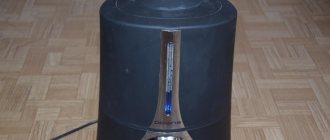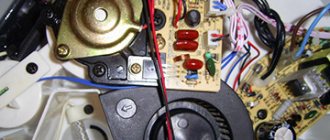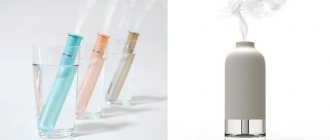Drying mode in an air conditioner - what is it?
The dehumidification mode in the air conditioner is a program that helps reduce air humidity to a normal level. At the same time, a special system removes excess water from the flowing air while maintaining a comfortable temperature background. The optimal indicator of air humidity in residential premises is the range from 40 to 60%.
An increase in this value leads to:
- deterioration in people's well-being;
- the development of fungi on the surface of the walls;
- proliferation of pathogenic microorganisms.
This mode helps dry the air, making it more comfortable for humans. This function is inherent in “premium” or “middle” class systems. On remote controls it is displayed with a special icon.
What is the dehumidification function for in an air conditioner?
Air conditioning dehumidification is necessary when:
- Living in areas of high humidity.
- The placement of devices in the apartment that excessively humidify the air.
- The harmful effects of excess humidity on household appliances and books.
- Increased risk of mold growth.
- Mustiness in the rooms.
- Flooding of space due to burst pipes.
Please note: Not all climate systems dehumidify the same way! Rooms with excessive moisture require powerful equipment that can dry quickly.
There is a category of citizens who do not tolerate high air humidity. Because of this, their existing diseases not only worsen, but also the risk of developing rhinitis, asthma or allergies increases. Therefore, it is worth installing an air conditioner with a “drying” function in the premises.
You may be interested in: Electricity consumption of an air conditioner
Air conditioning dehumidification
One of the functions that we forget about and do not pay attention to when operating an air conditioner is dehumidification. We are accustomed to thinking that an air conditioner only cools the air and this makes us comfortable.
But we would not be so comfortable without this function. I propose to familiarize yourself in more detail with the dehumidification function, what effect it has on our microclimate and how the mechanism of its action occurs.
This process occurs thanks to the refrigeration circuit, which turns on in cooling mode, at this moment the heat exchanger reaches the lowest possible temperature, and the fan turns on at minimum speed. Thanks to the slow blowing of the cold heat exchanger, maximum condensation of moisture taken from the air occurs. In general terms, the maximum amount of moisture is extracted from the minimum amount of air.
Drying with air conditioning helps reduce the load on our body, which is aimed at maintaining water and electrolyte balance.
This lies in the fact that the air conditioner not only cools the air, but also reduces its humidity. Consequently, the level of moisture we consume and produce is reduced.
This function also has maximum efficiency in rooms with high humidity. It is known that in such a microclimate it is very convenient for harmful bacteria to multiply, which negatively affect human health. Thanks to the air conditioner, even such a room, or rather its microclimate, does not pose a danger to human health.
This is especially true in the fall, when it is very cold outside and the heating has not yet been turned on. The humidity in the room increases sharply, and droplets of water appear on the windows and even walls. If you leave the situation to its own devices, mold will very quickly grow from these droplets.
Even if the heating is turned on, several days will pass before the room warms up and condensation on the windows and walls stops forming. During this time, black spots may appear on the walls. Those. there are two options: either run around with a rag all the time, check the windows and walls, wipe off the water, or turn on the air conditioner in dehumidifying mode. The second option will certainly be the best.
The air conditioner can easily remove up to 1-2 liters of water from a room in an hour, and can operate in this mode either with parallel air cooling or alone.
You can get acquainted with models of air conditioners with a dehumidifying function in our catalog.
Operating principle of the “drying” mode
The principle of operation of climate control equipment in the specified mode begins with the launch of the “Dry” option. Translated into Russian, this concept is interpreted as “drying”. The location of the described option can be on the touch panel in the form of a line or placed as a separate button on the remote control. This program starts working by pressing the remote control.
The operation of a dehumidification system is similar to that of air cooling:
- radiator cooling in the indoor unit;
- contact of air masses forced by the fan with the radiator walls;
- heat transfer by air;
- condensation of moisture from the air onto the surface of the radiator;
- collecting liquid with special tubes and then removing it through a drainage hose;
- return flow of cold air into the space.
Please note: A container must be installed next to the drainage hose to collect the draining liquid. Periodically it requires emptying!
Approximate cycle of operation of a split system:
- drying (10 min);
- switching off the device (5 min);
- increased ventilator activity (2 min);
- repeat the cycle.
Ventilation
This air conditioner mode (fan) uses only the fan in the indoor unit, which draws in air from outside without heating or cooling it. The use of this function is especially important if the room is heated using a central heating system.
It is possible to turn off the supply of outdoor air, turning the air conditioner into a “mixer” of air masses in the room, where the lower and upper layers are heated with different intensities (warm air collects closer to the ceiling, and colder air below).
More technically advanced models have the ability to adjust the fan speed, so you can set different ventilation intensities.
Advantages and disadvantages of dehumidification mode
The process of drying air with a climate control system has its disadvantages:
- Failure of the device leads to loss of the “Dry” function.
If the unit fails, the air conditioner will not be able to dry the air.
- It is not advisable to use in winter.
In winter, the dehumidifier will remove the already low moisture content from the air (the main amount will be dried by the heating system). Lack of fluid in the air space stimulates the development of hair and skin problems.
- An excessive number of options interferes with the operation of the basic functions of the climate system.
The wide functional list of the air conditioner contributes to the creation of increased load on the unit. As a result, the effectiveness of all equipment may be reduced. When purchasing, you should choose models with the optimal set of options that will be used in the household.
- Reduced effectiveness of the “temperature increase” option.
You may be interested in: The air conditioner is squelching and gurgling, what should I do about it?
In the winter season, the “drying” function will not be able to create a full-fledged operation of the “heating” program.
Despite so many disadvantages, the “Dry” option also has its advantages:
- Indoor comfort.
Timely turning on and off of this mode will create the most optimal microclimate in the room, taking into account the preferences of all family members.
- Space saving.
Including the described option in the air conditioner deprives the owners of the premises of the need to purchase an additional dehumidifier.
- Adjustment of humidity and temperature.
Supplementing the functionality of a split system with this option creates the most comfortable conditions for regulating humidity and temperature.
Cooling and heating
Cooling has always been and remains the main purpose of any air conditioner. It occurs through the use of a physical process in which the refrigerant, passing from a liquid to a gaseous state, absorbs heat from the environment. This leads to cooling of the air flow entering the room (accompanied by a drying effect due to the removal of moisture from the air). It is necessary to calculate the power of an air conditioner for cooling as follows: for every 8-10 square meters of area, 1 kW of power is required for normal operation of the device.
The “warm” version of the air conditioner (with the heat pump function) allows you to produce 300-400% more heat compared to the electricity consumed for this. In this regard, its use in the spring-autumn period is energetically feasible, and the modes justify their presence.
However, in winter, when the temperature drops significantly below zero, compressor oil and freon in air conditioners change their properties. This may lead to rapid failure of the device due to operation in unsuitable conditions. The solution to the problem is the use of a special “winter kit” (which serves for additional heating of the entire system), which allows you to expand the range of “operating” temperatures to -30 C. However, in addition to converting the air conditioner into a heater, you will receive a device that shamelessly “eats” electricity (from - for low efficiency) and your money.
There is a separate class of air conditioners equipped with a heating element. They also use a lot of electricity and are not cost effective (compared to other types of heaters).
When and how to turn on the mode
As you know, heat is more difficult to tolerate in high air humidity. Therefore, in such cases, turning on the “Dry” option allows you to breathe more comfortably. You can turn it on if necessary by pressing the corresponding button on the remote control or by clicking on the desired menu line. The “Dry” option leads to the disappearance of stuffiness, making the air more comfortable to breathe. By the way, the temperature background does not change!
Most household split systems are capable of removing excess moisture from the air, while minimizing the risk of developing many unpleasant consequences for the body and apartment. Thus, setting the set temperature in the room leads to the inclusion of the “Dry” mode. As soon as the humidity becomes optimal, a sensor is triggered giving a command to reduce the fan speed.
A special valve helps maintain a comfortable temperature for residents in the room when the “drying” option is turned on. It is its activity that helps block the flow of freon to the heat exchanger.
Of course, the inclusion of a “drying” function in the air conditioner is a big plus for its owners. You just need to use such a unit when necessary, otherwise the dried air can negatively affect many interior items and human health.
Step-by-step instructions for turning on the air conditioner in dry mode
Before turning on the air conditioner, make sure that it is connected to the mains (the plug is plugged into the socket or the corresponding circuit breaker is turned on in the electrical panel).; Next, take the control panel and follow the steps in the step-by-step instructions for turning on the drying mode:
- Turn on the air conditioner by pressing the on/off button.
- a droplet or the word Dry appears on the remote control display .
- Next, use the Temp buttons or arrows to select the desired temperature. For example, we set it to 25 so that the air conditioner does not lower the temperature in the room below +25 degrees. Because In the drying mode of the air conditioner, its main task is to dry it, it is not a fact that it will maintain the set temperature.
- If you need to change the fan rotation speed, press the “Fan Speed” button (there may be “Fan” or “Speed” buttons).
- If you need to change the direction of the blinds flow, then look for the Swing button.










